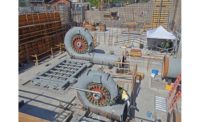"Each section was a process of scaffold build, pieces go up, then another scaffold build," Ahlin says.
Mostly because of hurdles such as the rescheduling tasks to overcome material shortages and the need to overcome unforeseen accessibility issues, the project did not meet its preconstruction target of beginning power generation by this summer. Smith says the current schedule is to begin generation in January.
"Was it perfect? No. Did we ever stop because of a lack of supply? No. We had to make planned choices," says Paul Houghton, Brahma Group project manager. "When it looked dark and bleak, everyone dug their heels in and said: 'We can do this.'"
Safety Program Takes New Approach
Construction of the tower's systems offered numerous safety hurdles. Yet the team posted zero lost-time accidents and an OSHA recordable incident rate of just 0.32 despite 3.76 million worker hours. The results were recognized by Best Projects judges with an award of merit in the Excellence in Safety category.
"Safety, for us, is our culture," Houghton says.
Part of the impetus for the project's safety ethos was Brahma's FLARE program—Field Level Assessment of Risk in the Environment—implemented by Jon Wickizer, Brahma's corporate health safety and environment director. Where many firms have similar programs where field workers assess risk daily, Brahma took FLARE up to the executive level by creating mobile apps and a Web interface. Crescent Dunes became the testing ground for these tools, Wickizer says.
"It doesn't just translate into safety. It also translates into how people are going about their work," Wickizer says.
Crescent Dunes Solar Energy Power Plant
Tonopah, Nev.
Key Players
General Contractor Cobra Thermosolar Plants, Las Vegas
Owners SolarReserve, Santa Monica, Calif.; Santander, Madrid; and ACS Cobra, Madrid
Lead Design Firm SolarReserve, Santa Monica
Structural/Civil Engineer Cobra, Madrid









